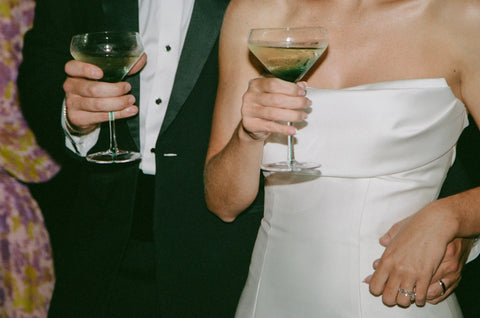As workplace dress codes continue to relax and social events become less rigidly defined, mastering the casual suit has become an essential skill for the modern man.
While many workplaces embrace "smart casual" as the new normal, the casual suit finds itself elevated from an occasional alternative to a cornerstone of the contemporary wardrobe. Whether you're attending a garden wedding, meeting clients for lunch, or enjoying weekend cocktails, the right casual suit can make you look polished without appearing overdressed.
We've observed this evolution firsthand through our work with clients across various occasions and settings. In this guide, we'll explore what makes a suit "casual," when and how to wear casual suits appropriately, and how to select styles that complement your personal aesthetic and body type.
Table of Contents
What Defines a Casual Suit?
A casual suit differs from its more formal counterparts in several key aspects, creating a distinct look that's appropriate for less formal occasions while maintaining an elevated sense of style.
Fabric and Texture
The most noticeable difference in casual suits is the fabric selection. While formal suits typically feature smooth, refined materials like fine worsted wool with minimal texture, casual suits embrace more textured, relaxed fabrics:
- Natural fibers: Cotton, linen, and casual wool blends (like tweed or flannel) are common
- Visible texture: Look for fabrics with noticeable weaves or patterns like herringbone, hopsack, or seersucker
- Seasonal weights: Lighter, more breathable fabrics for warm weather and heartier textures for cooler months
Construction and Structure
Casual suits feature less rigid construction than their formal counterparts:
- Minimal shoulder padding: Softer, more natural shoulder lines create a relaxed silhouette
- Lighter canvas: Less internal structure allows for greater movement and comfort
- Unstructured or partially lined: Many casual suits eliminate or reduce lining, creating a more relaxed drape
- Relaxed proportions: Slightly less tapered silhouettes provide ease of movement
Color and Pattern
While formal suits are typically limited to solid navy, charcoal, or subtle pinstripes, casual suits offer a broader palette:
- Expanded color range: Light grays, tans, browns, olive greens, and softer blues
- Bolder patterns: Broader checks, windowpanes, or textural patterns
- Seasonal variations: Lighter colors for spring/summer and deeper, richer tones for fall/winter
Details and Styling
Casual suits often incorporate more relaxed details:
- Patch pockets: Instead of the flap or jetted pockets found on formal suits
- Casual buttons: Horn, mother-of-pearl, or other distinctive button styles
- Contrast stitching: Visible stitching that adds visual interest
- Working buttonholes: Functional cuff buttons (sometimes left unbuttoned for a relaxed look)
The distinction between casual, business casual, and formal suits can be nuanced. Business casual typically involves separates (non-matching jackets and pants), while a casual suit maintains matching pieces but in relaxed fabrics and construction. Formal suits, by contrast, feature refined fabrics, structured construction, and minimal pattern or texture.
Essential Casual Suit Styles
The world of casual suits offers a diverse range of options suitable for different seasons, occasions, and personal preferences. Here are the essential styles worth considering for your wardrobe:
Warm Weather Casual Suits
Linen Suits: The quintessential summer casual suit, linen offers unparalleled breathability and a naturally relaxed appearance:
- Natural wrinkles are part of linen's charm and character
- Colors like tan, light blue, and cream are particularly effective
- Perfect for outdoor summer events, beach weddings, and resort wear

Cotton and Cotton Blend Suits: More structured than linen but still lightweight and breathable:
- Better wrinkle resistance than pure linen
- Seersucker and cotton twill offer interesting textures
- Versatile for spring through early fall wear
- The Black Tux offers several cotton options in both solid colors and subtle patterns
Lightweight Wool and Tropical Wool Suits: For those who prefer wool's drape but need warm-weather performance:
- High-twist yarns create breathable, lightweight fabrics
- More polished appearance than cotton or linen
- Maintain shape better throughout the day
- Ideal for summer business settings or dressier warm-weather events
Cool Weather Casual Suits
Textured Wool Suits: Fabrics like tweed, flannel, and hopsack provide warmth and visual interest:
- Flannel suits offer a soft hand-feel and subtle texture
- Tweed provides rustic charm and substantial warmth
- Hopsack offers year-round versatility with a distinct texture
- The Black Tux's gray flannel option has become a popular casual choice for fall and winter events
Corduroy Suits: A distinctive casual option with rich texture:
- Various wale (ridge) sizes create different visual effects
- Colors like burgundy, olive, and camel work particularly well
- Perfect for creative workplaces and weekend social events
Versatile Year-Round Options
Unstructured Blazers and Suit Separates: For maximum versatility:
- Navy hopsack blazers pair with multiple pant options
- Suit separates allow for creative mixing and matching
- The Black Tux's separate options allow for unique combinations to suit your personal style
Popular Colors for Casual Suits:
- Navy: The most versatile option that works year-round
- Light to medium gray: Perfect for spring through fall
- Tan and khaki: Ideal for warmer months and casual settings
- Olive: A distinctive option that pairs well with earth tones
- Burgundy and deep blue: Statement colors for the style-confident
These varied options allow you to build a casual suit collection that covers multiple seasons and occasions. The Black Tux offers several of these styles in our collection, with options like our bestselling light gray casual suit and navy unstructured blazer providing versatile foundations for any wardrobe.
When to Wear Casual Suits
Understanding when a casual suit is appropriate requires considering both the occasion and the expected dress code. Here's a guide to navigating various scenarios:
Social Occasions
Daytime Weddings: Particularly outdoor or "garden party" style events:
- Spring/summer garden weddings call for lightweight fabrics like linen or cotton
- Fall rustic weddings are perfect for textured wool or flannel suits
- Consider the venue and time of day—more casual settings welcome less structured suits
Cocktail Events: Many cocktail events specify "festive attire" or "creative formal":
- Casual suits in interesting textures or colors are ideal
- You can express personality through fabric choice and styling
- More relaxed than black-tie optional, but still polished
Casual Friday Dinners and Social Gatherings: Weekend social events with friends or colleagues:
- Unstructured blazers with matching pants strike the right balance
- Opportunity to showcase personal style while remaining put-together
- Perfect middle ground between overly formal suits and too-casual separates
Professional Settings
Smart Casual Workplaces: Many modern offices have adopted more relaxed dress codes:
- Cotton or lightweight wool suits in navy or gray provide versatility
- Creative industries welcome more distinctive casual suit options
- Tech and startup environments favor unstructured options
Business Casual Interpretation: When you need to maintain professionalism with modern sensibility:
- Textured wool suits without ties create an approachable yet authoritative look
- Consider darker colors and minimal patterns for more conservative settings
- Unstructured suits can bridge the gap between traditional and contemporary
Industry-Specific Considerations:
- Creative fields (design, advertising, media): Bolder casual suit choices are welcome
- Client-facing roles in traditional industries: More conservative casual suit options
- Teaching/academia: Tweed and other textured options have a long tradition
Seasonal Appropriateness
Matching your casual suit to the season enhances both comfort and style:
- Spring: Lightweight wool or cotton in medium to light colors
- Summer: Linen, seersucker, or tropical weight fabrics in light colors
- Fall: Medium-weight wool, flannel, or corduroy in deeper tones
- Winter: Heavier textured fabrics like tweed or substantial flannel
Understanding the distinction between "smart casual," "creative formal," and other ambiguous dress codes can be challenging. When in doubt, a well-chosen casual suit in an appropriate fabric offers versatility that can be dressed up or down as needed.
How to Style Casual Suits
The versatility of casual suits extends to how you can style them, offering significantly more flexibility than formal business attire. Here's how to create cohesive looks for different occasions:
Shirt Pairings
Button-Down Shirts: The most versatile option for casual suits:
- Oxford cloth button-downs (OCBDs) in white, light blue, or subtle patterns
- Chambray shirts for a more textural, relaxed appearance
- Patterned shirts (checks, small florals, subtle stripes) add visual interest
Polos and Knit Shirts: For a more relaxed but still polished appearance:
- Fine-gauge knit polos in solid colors create a refined casual look
- Long-sleeve knit shirts offer a European-inspired alternative to traditional button-ups
- Consider texture contrast between the suit and shirt for added dimension
T-Shirts: For the most casual interpretation (appropriate only in truly relaxed settings):
- Stick with high-quality, well-fitted crew necks in solid colors
- Avoid graphics or logos
- Best with unstructured cotton or linen suits in warmer months
Footwear Options
Your shoe choice significantly impacts how casual your suit appears:
Loafers and Slip-Ons: The perfect middle ground:
- Penny loafers offer timeless versatility
- Suede loafers provide textural interest and casual flair
- Bit loafers add a distinctive touch to simple suit styles
Chelsea Boots and Chukkas: For a modern, slightly edgy approach:
- Suede Chelsea boots pair exceptionally well with textured wool suits
- Leather chukkas bridge formal and casual effectively
- Consider color coordination with your suit (brown tones with navy, gray, or tan)
Clean, Minimal Sneakers: For contemporary casual styling:
- Stick with premium leather or suede sneakers in solid colors
- Avoid athletic styles—opt for dress sneakers or minimalist designs
- White sneakers work particularly well with lighter-colored summer suits
Accessorizing Casual Suits
Accessories can elevate or relax your casual suit as needed:
Neckwear Options:
- Knit ties offer texture without formality
- Wool, linen, or cotton ties depending on season
- Tie bars optional and generally less formal
Pocket Squares:
- Casual fabrics like cotton, linen, or wool rather than silk
- Puff or casual fold rather than precise arrangements
- Colors that complement rather than exactly match other elements
Additional Accessories:
- Casual watches with leather, canvas, or NATO straps
- Woven or casual leather belts that match your shoes
- Simple lapel pins or fabric boutonnieres for a distinctive touch
Casual Suit Styling Dos and Don'ts
Dos:
- Embrace textural contrast between different elements
- Consider the complete outfit proportion and color harmony
- Allow some strategic wrinkles with linen or cotton suits
- Mix in denim or chinos with casual suit jackets for maximum versatility
Don'ts:
- Avoid overly formal accessories with casual suits (French cuff shirts, formal silk ties)
- Skip highly structured or padded garments when aiming for a relaxed look
- Don't match pocket squares precisely to ties or other accessories
- Avoid athletic or overly casual footwear (running shoes, flip-flops)
The beauty of casual suits lies in their adaptability. The same suit can transition from a business meeting with a button-down and loafers to an evening event with a knit polo and Chelsea boots, making them an exceptionally versatile wardrobe investment.
Finding the Perfect Casual Suit
Selecting a casual suit that flatters your build and meets your needs requires attention to both fit and fabric. Here's how to find your ideal match:
Fit Considerations for Casual Suits
Casual suits generally feature a more relaxed fit than their formal counterparts, but "relaxed" doesn't mean "baggy":
Jacket Fit:
- Shoulders should still align with your natural shoulder
- Slightly less waist suppression than formal suits
- Sleeve length showing ¼ to ½ inch of shirt cuff
- Overall length covering the seat but not extending too far down the thigh
Trouser Fit:
- Higher rise than casual pants but potentially lower than formal suit pants
- Room through the thigh without excess fabric
- Slight taper through the leg for a clean line
- Hem options include no break for a modern look or slight break for a more classic appearance
Overall Silhouette:
- The goal is a relaxed, natural appearance rather than rigid structure
- Allows for comfortable movement without appearing sloppy
- Different body types require different approaches to casual suit proportions
Proper Measurements for Casual Suits
Even with a relaxed fit, proper measurements remain crucial:
- Chest: Measured at the widest point with room to button comfortably
- Shoulders: Should align with your natural shoulder point
- Waist: Where the pants will sit (typically at or just below the natural waist)
- Inseam: Length from crotch to desired hem position
- Sleeve length: From shoulder to just above wrist bone
The Black Tux's virtual fitting technology eliminates guesswork by providing precise measurements tailored to each suit style's intended fit. Our fit guarantee ensures any necessary adjustments are addressed before your event.
Renting vs. Buying Casual Suits
When considering casual suits, both rental and purchase options offer distinct advantages:
Rental Benefits:
- Try multiple styles to find what works best for your body type and preferences
- Access premium fabrics and construction at a fraction of purchase cost
- Perfect for occasional wear or specific events
- Sustainable approach to fashion consumption
- The Black Tux offers high-quality casual suit rentals with premium construction and materials
Purchase Considerations:
- Investment for frequent wear
- Opportunity for tailoring to your precise measurements
- Building a capsule wardrobe of versatile pieces
For many men, a combination approach works best—owning foundational pieces like a navy hopsack blazer while renting statement pieces for specific occasions.
Body Type Considerations
Different physiques benefit from specific casual suit approaches:
Athletic Build:
- Moderate shoulder structure balances broader shoulders
- Sufficient room through chest and upper back
- Tapered waist to maintain proportion
Slim Build:
- Lighter padding can add subtle structure
- Jackets with some texture add visual weight
- Moderate tapering maintains clean lines without appearing too skinny
Larger Build:
- Structured shoulders create balanced proportions
- Darker, solid fabrics have a slimming effect
- Proper fit is crucial—not too tight but not oversized
The Black Tux offers casual suit options in various cuts to accommodate different body types, with comprehensive sizing guidance to help you find your perfect match.
Making Casual Suits Work for You
The casual suit has evolved from a niche garment to an essential component of the modern man's wardrobe. As workplace dress codes continue to relax and social occasions embrace more personal style expression, mastering casual suiting opens up new possibilities for creating distinctive, appropriate looks across various settings.
The key to successful casual suit wearing lies in understanding the balance between relaxed and refined. While these suits offer more flexibility in fabric, fit, and styling than their formal counterparts, they still require thoughtful attention to proportion, quality, and occasion-appropriateness.
By considering factors like fabric selection, fit preferences, and accessory choices, you can build a versatile casual suit wardrobe that serves multiple purposes throughout the year.
We offer a comprehensive approach to casual suiting, with premium rental options, expert fit guidance, and curated style advice to help you navigate this versatile garment category. Explore our casual suit collection to discover options that align with your personal style and upcoming occasions.
Frequently Asked Questions
What makes a suit casual?
A casual suit is defined by relaxed fabric (like cotton, linen, or textured wool), less structured construction (minimal padding and lining), and more relaxed details (patch pockets, natural shoulders). The overall effect is polished but not rigid or formal.
Can you wear a casual suit to a wedding?
Casual suits are perfect for many wedding scenarios, particularly daytime, outdoor, or "garden party" events. Consider the dress code, season, and venue—lightweight fabrics like linen or cotton work well for summer weddings, while textured wool suits are ideal for fall celebrations.
How do you style a casual suit with sneakers?
When pairing sneakers with a casual suit, opt for clean, minimal designs in premium materials like leather or suede. White sneakers work exceptionally well with lighter-colored suits. Keep the rest of your outfit simple—a clean button-down or quality t-shirt completes the look without appearing forced.
What are the best fabrics for summer casual suits?
The best summer casual suit fabrics include linen (most breathable but wrinkles easily), cotton (more structure than linen with good breathability), seersucker (built-in texture with air circulation), and tropical wool (lightweight wool that breathes well while maintaining shape).
Are casual suits appropriate for office wear?
Casual suits can be appropriate for many modern workplaces, particularly those with "smart casual" or "business casual" dress codes. For more conservative environments, choose darker colors and minimal patterns, while creative industries welcome more distinctive casual suit options.
How should a casual suit fit compared to a formal suit?
Casual suits typically feature a slightly more relaxed fit than formal suits, with less structured shoulders, slightly less waist suppression, and a more natural drape. However, "relaxed" doesn't mean "baggy"—the suit should still follow your body's natural lines while allowing comfortable movement.









